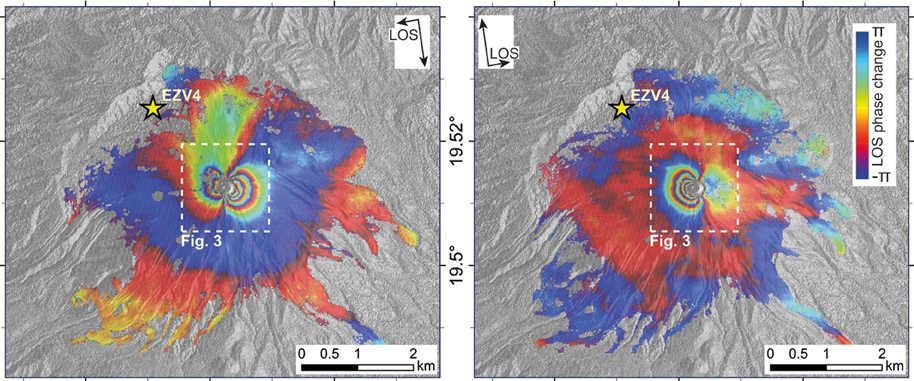Satellite radar data reveal short-term pre-explosive displacements and a complex conduit system at Volcán de Colima, Mexico
Jacqueline T. Salzer1*, Mehdi Nikkhoo1, Thomas R. Walter1, Henriette Sudhaus1,2, Gabriel Reyes-Dávila3, Mauricio Bretón3 and Raúl Arámbula3
1Department 2: Physics of the Earth, GFZ German Research Centre for Geosciences, Potsdam, Germany
2Institute of Earth and Environmental Science, University of Potsdam, Potsdam, Germany
3Observatorio Vulcanologico de la Universidad de Colima, Colima, Mexico
The geometry of the volcanic conduit is a main parameter controlling the dynamics and the style of volcanic eruptions and their precursors, but also one of the main unknowns. Pre-eruptive signals that originate in the upper conduit region include seismicity and deformation of different types and scales. However, the locality of the source of these signals and thus the conduit geometry often remain unconstrained at steep sloped and explosive volcanoes due to the sparse instrumental coverage in the summit region and difficult access. Here we infer the shallow conduit system geometry of Volcán de Colima, Mexico, based on ground displacements detected in high resolution satellite radar data up to 7 h prior to an explosion in January 2013. We use Boundary Element Method modeling to reproduce the data synthetically and constrain the parameters of the deformation source, in combination with an analysis of photographs of the summit. We favor a two-source model, indicative of distinct regions of pressurization at very shallow levels. The horizontal location of the upper pressurization source coincides with that of post-explosive extrusion. The pattern and degree of deformation reverses again during the eruption; we therefore attribute the displacements to transient (elastic) pre-explosive pressurization of the conduit system. Our results highlight the geometrical complexity of shallow conduit systems at explosive volcanoes and its effect on the distribution of pre-eruptive deformation signals. An apparent absence of such signals at many explosive volcanoes may relate to its small temporal and spatial extent, partly controlled by upper conduit structures. Modern satellite radar instruments allow observations at high spatial and temporal resolution that may be the key for detecting and improving our understanding of the generation of precursors at explosive volcanoes.
Front. Earth Sci., 27 June 2014 | doi: 10.3389/feart.2014.00012

